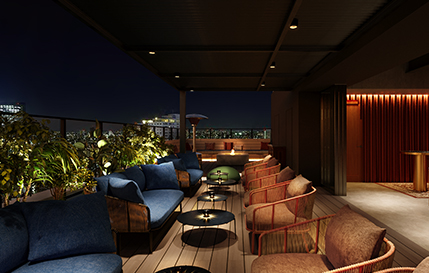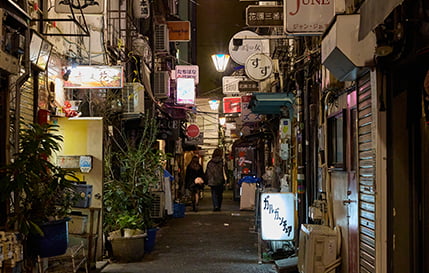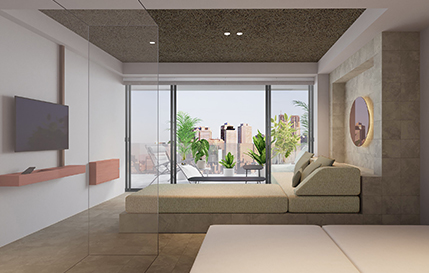Art through community collaboration (1) 1st floor tapestry

The artwork at the entrance is dyed with tapestries at “Tomita Dyeing Crafts”, which has a workshop in Shinjuku-ku.
Shinjuku is one of Japan’s three major dyeing production areas, along with Kyoto and Kanazawa.
Tokyo’s dyeing culture began in the Edo period in Kanda Konyacho, but as the urbanization of the Kanda River basin progressed, it changed to go up the river in search of clear streams, and in the 30s, more than 300 dyeing-related businesses were concentrated in Shinjuku Ward.
In this artwork, in order to express the concept of “NEO”, the dyeing culture that has been passed down in Shinjuku is reinterpreted in a modern style and expressed as art that harmonizes with the space.
The graphics are by artist Keita Miyairi, and express the duality of Shinjuku with the motif of people passing by the city and nature. This is also used to design room keys.

- profile
- Tomita Dyeing Crafts was founded in the current location in 1914. In search of the clear stream of the Kanda River, the dyeing industry has taken root in Shinjuku for more than 140 years, inheriting Tokyo’s dyeing and dyeing Edo komon and Edo chintz.
The traditional techniques that have been passed down since ancient times have now changed their shape not only to kimono but also to works that are suitable for modern lifestyles, such as ties, scarves, and handkerchiefs, and continue to evolve into dyeing that suits modern life while conveying the sense of fashion that has continued since the Edo period.
- comment
- Tomita Dyeing Crafts began in 1882 as a chintz dyeing workshop.
We still have a workshop in Shinjuku Ward and continue to dye. We used the Edo chintz technique, which has been passed down for more than 140 years since that time, to create tapestries.
One of the major features of Edo chintz is the use of patterns. This time, too, we started with the work of carving out the pattern rather than the design. The tool used is a brush made of deer hair, which is dyed by soaking the dye into the brush and rubbing it into the fabric many times.
Repeated trial dyeing to produce bright colors, and careful application of dye creates a uniform dyeing and clear boundary. Another feature of chintz is that it creates a texture by layering colors.
Please pay attention to the fact that different colors overlap to create a unique taste.
We are very honored to be able to cooperate with the tapestry that adorns the entrance of SHINJUKU.
As a workshop that has inherited Edo dyeing for nearly 140 years, I would like to express my sincere gratitude for giving me a place where I can make use of its traditional techniques while searching for ways to preserve its techniques and patterns that have been passed down in addition to kimonos. We hope that everyone who sees it will feel the “chic” of Edo that has been passed down to this land as seen in modern design.

- profile
- Keita Miyairi
Born in 1974, he is a pattern dyer and dyer from Tokyo.
- About the work
- Diverse people of men, women, adults, children, and races face each other with smiles and enjoy the company.
The overlapping colors create new colors, and the vibrant and colorful visuals evoke the bustling energy and diversity of Shinjuku.
The urban color scheme boldly combines blue and black to create a more sophisticated impression.
Not only people’s faces, but also icons such as cityscape, nature, music, and alcohol are scattered to visually depict the rich and deep charm of Shinjuku.







